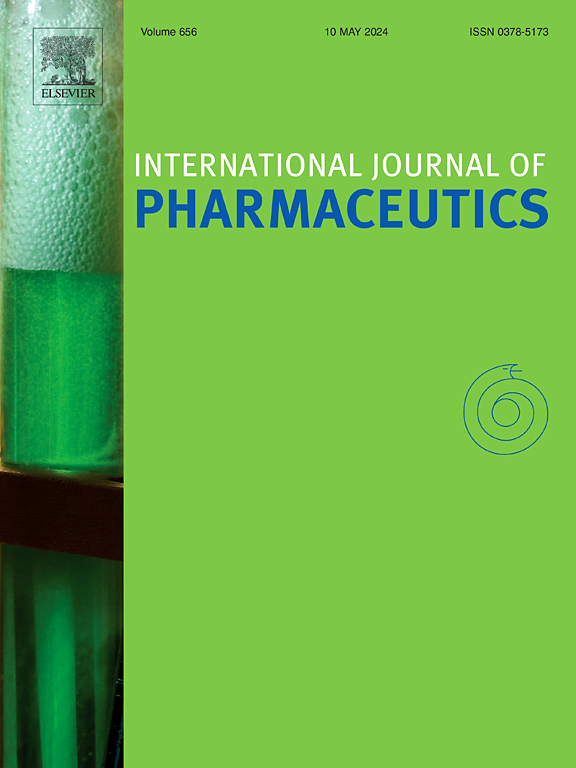Targeted hepatic delivery of ezetimibe via red blood cell-coated nanoparticles for the treatment of non-alcoholic fatty liver disease through inflammation modulation
IF 5.2
2区 医学
Q1 PHARMACOLOGY & PHARMACY
引用次数: 0
Abstract
This study investigates the potential of red blood cell (RBC) membrane-coated, ezetimibe-loaded poly(lactic-co-glycolic acid) (PLGA) nanoparticles for targeted therapy of non-alcoholic fatty liver disease (NAFLD). PLGA nanoparticles were fabricated and subsequently camouflaged with RBC membranes to enhance hepatic targeting. The nanoparticles were characterized for size, surface potential, and encapsulation efficiency. Physicochemical characterization revealed increased particle size upon membrane coating (PLGA: 221.2 ± 26.0 nm; RBC-PLGA: 255.2 ± 14.1 nm), corroborated by transmission electron microscopy. In vitro release kinetics were systematically evaluated, showing sustained drug release for both formulations. Biodistribution studies in rats demonstrated predominant hepatic accumulation of both nanoparticles, with higher liver deposition observed for RBC-PLGA (106.43 ± 40.08 µg) compared to uncoated PLGA nanoparticles (101.41 ± 34.15 µg). In vivo efficacy was assessed in a high-fat diet-induced NAFLD rat model. All ezetimibe-treated groups exhibited significant reductions in serum cholesterol levels, hepatic lipid accumulation, and liver enzyme activities. Metabolomics and lipidomics analyses further revealed that RBC-PLGA nanoparticles induced the most pronounced alterations in hepatic metabolic and lipid profiles. Moreover, studies demonstrated route-dependent modulation of key proteins implicated in NAFLD pathogenesis. Collectively, these findings suggest that RBC membrane-coated nanoparticles significantly enhance the liver-specific delivery and therapeutic efficacy of ezetimibe in NAFLD, while offering mechanistic insights into metabolic and lipidomic modulation associated with different administration routes.

通过红细胞包被纳米颗粒靶向肝递送依折替米,通过炎症调节治疗非酒精性脂肪性肝病。
本研究探讨了红细胞(RBC)膜包被、装载依替米比的聚乳酸-羟基乙酸(PLGA)纳米颗粒靶向治疗非酒精性脂肪性肝病(NAFLD)的潜力。制备PLGA纳米颗粒,随后用红细胞膜伪装以增强肝脏靶向性。对纳米颗粒的尺寸、表面电位和包封效率进行了表征。物理化学表征表明膜涂层后颗粒尺寸增大(PLGA: 221.2 ± 26.0 nm; RBC-PLGA: 255.2 ± 14.1 nm),透射电镜证实了这一点。体外释放动力学系统评估,显示持续的药物释放两制剂。大鼠的生物分布研究表明,这两种纳米颗粒主要在肝脏积聚,RBC-PLGA的肝脏沉积(106.43 ± 40.08 µg)高于未包被的PLGA纳米颗粒(101.41 ± 34.15 µg)。在高脂肪饮食诱导的NAFLD大鼠模型中评估体内疗效。所有依zetimibe治疗组均表现出血清胆固醇水平、肝脏脂质积累和肝酶活性的显著降低。代谢组学和脂质组学分析进一步显示,红细胞- plga纳米颗粒诱导肝脏代谢和脂质谱发生最显著的变化。此外,研究表明NAFLD发病机制中涉及的关键蛋白的通路依赖性调节。综上所述,这些研究结果表明,红细胞膜包裹纳米颗粒显著增强依zetimibe在NAFLD中的肝脏特异性递送和治疗效果,同时为不同给药途径相关的代谢和脂质组学调节提供了机制见解。
本文章由计算机程序翻译,如有差异,请以英文原文为准。
求助全文
约1分钟内获得全文
求助全文
来源期刊
CiteScore
10.70
自引率
8.60%
发文量
951
审稿时长
72 days
期刊介绍:
The International Journal of Pharmaceutics is the third most cited journal in the "Pharmacy & Pharmacology" category out of 366 journals, being the true home for pharmaceutical scientists concerned with the physical, chemical and biological properties of devices and delivery systems for drugs, vaccines and biologicals, including their design, manufacture and evaluation. This includes evaluation of the properties of drugs, excipients such as surfactants and polymers and novel materials. The journal has special sections on pharmaceutical nanotechnology and personalized medicines, and publishes research papers, reviews, commentaries and letters to the editor as well as special issues.

 求助内容:
求助内容: 应助结果提醒方式:
应助结果提醒方式:


